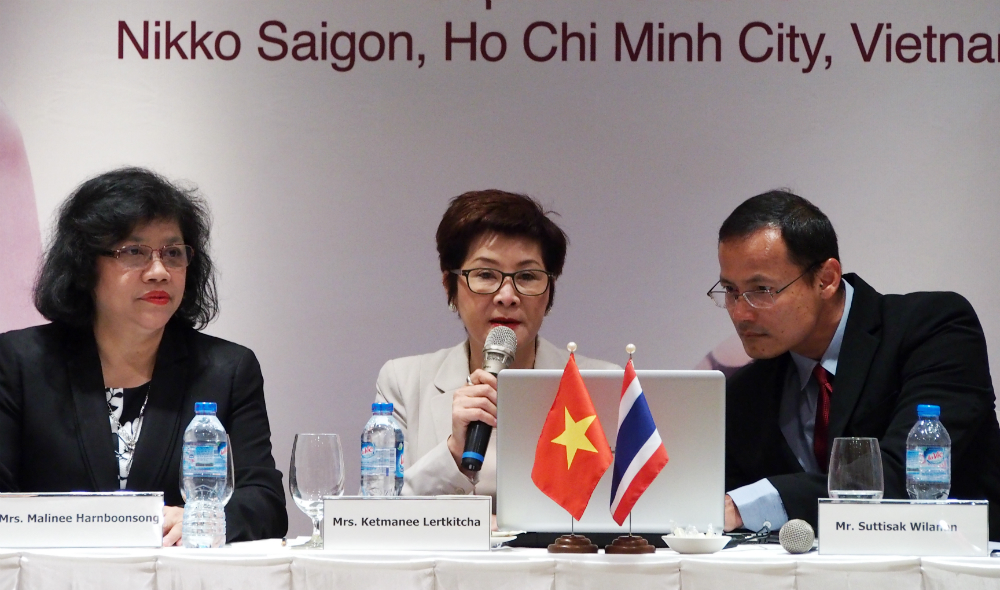The cosmetics industries of Vietnam and Thailand should accelerate cooperation to make use of the two sides’ advantages ahead of the establishment of the ASEAN Economic Community (AEC), the president of the Thai Cosmetic Manufacturers Association said at a workshop in Ho Chi Minh City last week.
The AEC, to be formed by the end of 2015, is aimed at creating a single market and production base, a highly competitive economic community, a region of equitable economic development, and one fully integrated into the global economy, according to the ASEAN website.
ASEAN is a ten-member bloc which includes such Southeast Asian countries as Indonesia, Malaysia, the Philippines, Singapore, Thailand, Brunei, Cambodia, Laos, Myanmar, and Vietnam.
Thailand has advanced technology and innovation in the production of cosmetic and personal care products, Ketmanee Lertkitcha, president of the association, said at the workshop on opportunities for cooperation between Vietnam and Thailand on Wednesday.
The country also has a plentiful supply of natural ingredients, such as 200,000 kinds of herbs and vegetable oils, which are necessary for a closed chain of production, from raw materials to finished products, Ketmanee said.
Vietnam shares very similar abundance in natural resources for the cosmetics industry with Thailand, the president added.
The two countries should cooperate by sharing research, development and technological innovations in the industry, she advised.
Ketmanee revealed that Thailand’s cosmetics and personal care sectors earned over US$2 billion in exports in 2013, 26 percent of which was from ASEAN, followed by Japan (27 percent) and the EU (7.7 percent).
Thailand is considered the second-largest shampoo supplier and 12th-largest provider of skincare products in the world, she said.
The world’s cosmetics market is projected to grow at 8-10 percent annually, with consistent growth in demand for health and beauty products, for both women and men, she added.
In 2014, the total revenue of the cosmetics industry in Thailand was 250 billion baht ($6.8 million), and the number is expected to rise to 275 billion baht ($7.55 million) this year.
Malinee Harboonsong, a commercial consul at the Consulate General of Thailand in Ho Chi Minh City, said the Vietnamese cosmetics industry would benefit hugely when cooperating with the Thais, as the two sides could expand their market share within the AEC as well as in the global market.
In addition, Vietnam and Thailand share the same development path given their current economic status, she said.
In the past five years, the average growth rate of bilateral trade between the two countries has reached 13 percent per year. In 2014, trade between Vietnam and Thailand topped $12 billion.
In the first five months of 2015, the trade value between the two countries increased 9.8 percent, and may grow even stronger later this year, Malinee predicted.
Cooperation will also create a chance for Vietnamese consumers to buy Thai cosmetic products at better prices, given increasing income and consumer preferences which require more products with high quality and a brand reputation, according to the commercial consul.
That is why Thailand’s cosmetic and personal care products are becoming increasingly popular with consumers in Vietnam, she said.
Hence, the need for cooperation and support between the manufacturers and businesses of the two countries are essential to the development of the industries based on the principle of mutual benefit, Malinee added.
The establishment of the AEC would lead to Vietnamese enterprises benefiting from the elimination of taxes, which will accelerate the flows of goods, services, investment and manpower while production and the supply chain of the region will operate faster and more efficiently, she said.
Like us on Facebook or follow us on Twitter to get the latest news about Vietnam!





















































